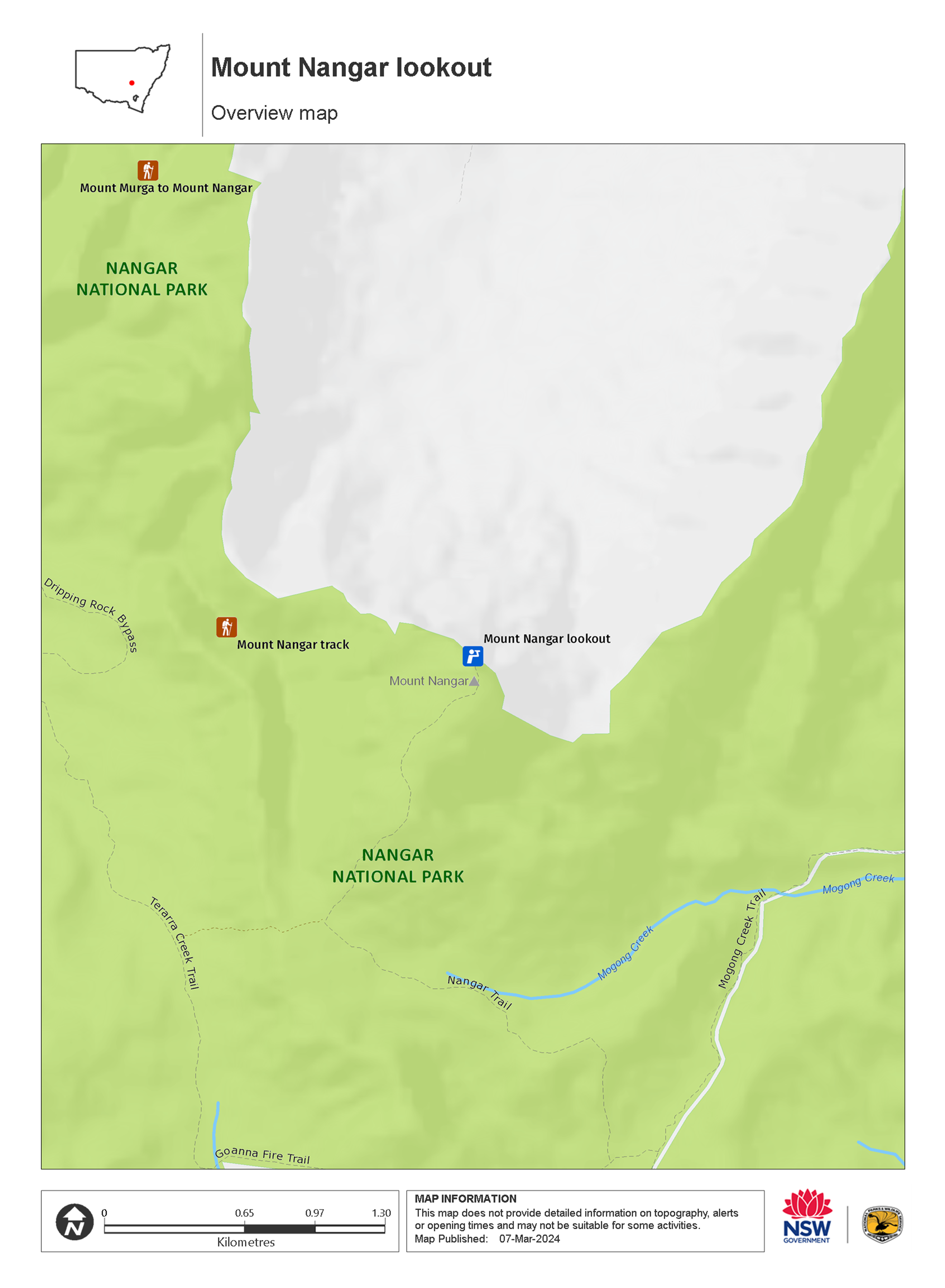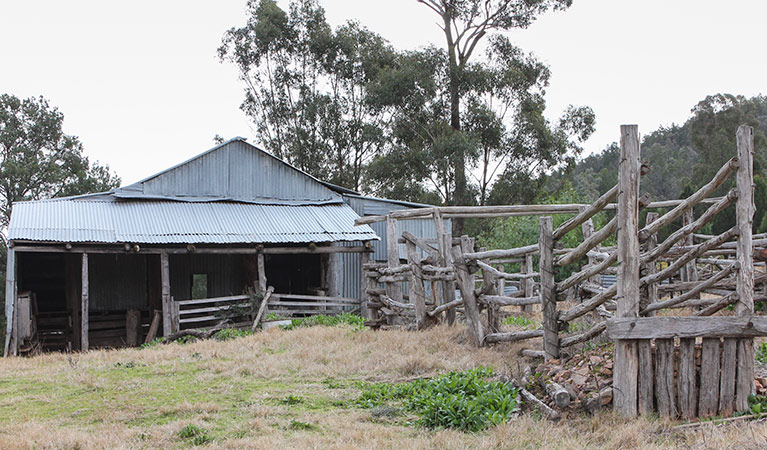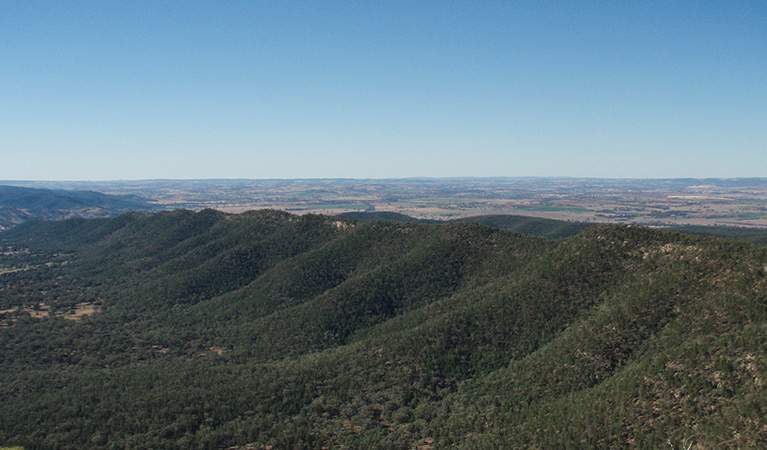Mount Nangar lookout
Nangar National Park
Overview
Go bushwalking, or 4WD, to Mount Nangar lookout for scenic views of the surrounding country and to enjoy great birdwatching, close to Orange and Forbes.
- Type
- Lookouts
- Where
- Nangar National Park in Country NSW
- What to
bring - Hat, sunscreen, drinking water
- Please note
- There is limited mobile reception in this park
- Remember to take your binoculars if you want to bird watch
As well as giving you terrific scenic views across the farming country of central west New South Wales, spending time at Mount Nangar lookout offers a sense of the importance of this conserved area of bushland. The wooded hills and ridge make a dramatic contrast with the endless fields and provide an important refuge for the resident kangaroos, wallabies, bats and birdlife.
You can take Mount Nangar hiking track down to Dripping Rock from the lookout, through valleys of mugga ironbark and red stringybark woodlands. In spring, you’ll see a variety of delicate wildflowers and while birdwatching, you may catch sight of peregrine or brown falcons and wedge-tailed eagles soaring above the ridge line. Bring your camera – the scenery is varied and the views dramatic.
Map

Map legend

Local alerts
For the latest updates on fires, closures and other alerts in this area, see https://uat.nswparks.cloud/things-to-do/lookouts/mount-nangar-lookout/local-alerts
General enquiries
- National Parks Contact Centre
- 7am to 7pm daily
- 1300 072 757 (13000 PARKS) for the cost of a local call within Australia excluding mobiles
- parks.info@environment.nsw.gov.au
Park info
- in Nangar National Park in the Country NSW region
- Nangar National Park is always open but may have to close at times due to extreme weather or fire danger.
Visitor info
All the practical information you need to know about Mount Nangar lookout.
Maps and downloads
Learn more
Mount Nangar lookout is in Nangar National Park. Here are just some of the reasons why this park is special:
A refuge for wildlife

Amid the extensive farmlands of the central west, Nangar is home to many sedentary and migratory birds and local native animals. Among many bird species are several birds of prey such as the peregrine falcon, wedge-tailed eagle and brown falcon, which use the cliff face along the northern boundary for nesting and perching. The park is also home to the eastern grey kangaroo, common wallaroo, red-necked wallaby, swamp wallaby, little mastiff-bat and chocolate wattled bat. You may also spot the southern rainbow skink, eastern long-necked tortoise and spotted grass frog.
- Mount Murga walking track Enjoy scenic views, spring wildflowers, varied wildlife and birdwatching on Mount Murga walking track; great for a day of bushwalking near Orange and Forbes.
- Mount Nangar walking track Mount Nangar walking track to the lookout takes you bushwalking through varied landscapes to scenic views over Nangar National Park and surrounding farmlands in search of wildlife and wildflowers.
An ever-changing landscape

Ranging from the undulating hills in the south of the park to the long cliff line of red siltstone on the northern boundary - and the 770m-high Mount Nangar - the park offers a great variety of landscapes and views. Terarra Creek valley is open with wide creek flats and gentle slopes and the upper tributaries of Mogong Creek contains several natural springs. You'll see from the high vantage points of the park that the valley floor and more accessible lower slopes have been cleared by grazing and logging. Old growth forest is found in the steeper areas, but under national park protection, the park's vegetation communities will grow ever stronger.
- Mount Murga walking track Enjoy scenic views, spring wildflowers, varied wildlife and birdwatching on Mount Murga walking track; great for a day of bushwalking near Orange and Forbes.
- Mount Nangar walking track Mount Nangar walking track to the lookout takes you bushwalking through varied landscapes to scenic views over Nangar National Park and surrounding farmlands in search of wildlife and wildflowers.
Historic treasure

Gold was discovered around Eugowra in the 1860s, drawing miners and bushrangers, including the Gardener and Ben Hall gangs who roamed the area that the park now covers. Chinese miners lived here in the early 1900s, prospecting for copper. Historical remains in the park include remnants of gardens and orchards of Dripping Rock homestead, lost to fire in recent years, and its piggery, ruined hay shed and yards.
Wiradjuri country

A vast area of the central west of New South Wales, including Nangar National Park, is Wiradjuri country. Evidence suggests that Nangar Range has been an important landmark in Aboriginal culture and that the surrounding area was occupied for long periods. Places of significance include archaeological sites containing artefacts, stone scatters, quarries and scar trees.

